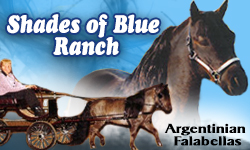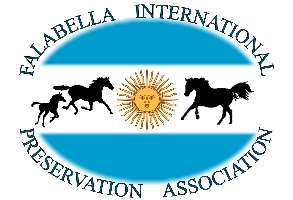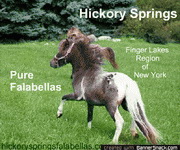There are many misconceptions about the Falabella breed, and I would like to take this opportunity to talk about a few of them. When Lord and Lady Fisher [from England] visited the Falabella ranch [in Argentina] in the early seventies they later reported that the horses were all running together and that stallions fought for and selected their own mares.As the late J.C. Falabella was a HORSEMAN, I thought this was unlikely and this was one of my main reasons for wanting to meet Maria Falabella - to get an answer to this question and a number of others, which had puzzled Falabella enthusiasts for many years......
Maria Falabella told me (through her interpreter and daughter-in-law Anna Maria) that the Falabellas are bred in herds of ten to fifteen mares and a stallion. When the herd is established it is moved to open fields with other herds and the strong family bonds keep each herd together as a unit. Because a number of unauthorized societies/registries have taken it upon themselves to endorse the idea of 'chaos' on the Falabella ranch I will also take this opportunity to quote from 'Horse Breeding' (www.davidandcharles.co.uk) by one of the U.K.'s most respected equine fertility experts Peter Rossdale.
'These groups (harems) retain their integrity over many years. The young males eventually leave the group to join bachelor groups, from which individuals break away to form new harems. These are composed of young maturing fillies, as they too leave their original group. Some older mares that have become stragglers from their original harem may be incorporated into the new group. Mating occurs between the family stallion and his mares. The presence of the stallion is respected by other stallions, so there is little or no fighting.'
I feel that it is most important this be fully understood as the 'chaos' theory is very convenient for the unauthorized societies whose horses often have rather short pedigrees - they tell their members that it would have been impossible to know which stallion had sired a foal! They also imply that pedigrees from the Falabella ranch have been somehow 'invented'!The Falabella is the Original miniature horse. It has been bred on the Falabella ranch in Argentina for over 150 years and its story began in 1845 when an Irish man named Patrick Newtall discovered that the tribes of pampas Indians had some unusually small horses along with their larger riding horses. He managed to obtain some and by 1853 he had created a herd of small, perfectly built little horses of around 102cms. In 1879 he transferred his findings, herd and knowledge to his son-in-law, Juan Falabella. Juan continued the experiment by using other breeds to develop this small horse...[using the] Criollo - the Argentine horse of the pampas.
In 1905 the herd was transferred to the next generation Emillio and in 1927 the Establishment was inherited by Julio Cesar Falabella who kept careful genealogical records, introduced the blood of several other breeds including the North American Appaloosa which gave the breed its spotting capability...! Some time after this he began to sell a few Falabellas to selected clients and the late John F. Kennedy was one of the first people to acquire some.
After Julio's death in 1980 the herd was split between his wife Maria L. B. de Falabella and his only child Maria Angelica who now resides in the USA retaining a breeding herd of around seventy horses.
The Falabella is linked to the earliest modern horses in the New World. The Spanish brought over Andalusian horses when they attempted to conquer the Americas, which were forced to fend for themselves when the would-be conquerors were forced to flee. To survive they had to undergo structural changes to cope with the variable climate of the pampas. Cold winds, strong sun and fierce storms are common. The land is arid and horses have to travel long distances to find pasture and water.
The Falabella is gentle and docile around people but retains plenty of 'fizz' around its herd-mates, indulging in 'horse-play'. They are long-lived and hardy, coping very well with cold weather although most of them would appreciate some protection from prolonged spells of rain.
There is another breed of miniature horse in Argentina known as the Bergman. These horses have some Falabella blood but ARE NOT FALABELLA! One society has imported a Bergman stallion believing it to be Falabella and have bred extensively with it. These foals have 'Falabella' papers! Remember that in order to be certain of obtaining a genuine Falabella you can request that it be registered with the British Falabella Studbook before you go ahead with the purchase. The BFS will 'parentage qualify' via the DNA test. The test can also pick up 'non Falabella' markers in cases where it is impossible to parentage-qualify - for example if one parent has died. Be VERY suspicious if a breeder refuses to register a horse with the BFS! Remember that there are FAR more part-bred Falabellas (with 'Falabella' papers) than genuine Falabellas. Because of the large sums of money involved breeders are loathe to admit their horses are not genuine - not of 100% Falabella bloodlines.
I would also like to draw attention to the fact that a number of unauthorized registries tell their members they can 'breed back to pure after five generations'. This is UNTRUE - one NEVER gets back to pure after someone has cheated in the pedigree!
People regularly contact me to say they know they have a genuine Falabella because it is very tiny and/or very refined. I try to explain that many of the part-breds (often with Falabella papers) are indistinguishable from genuine Falabellas. Only a long pedigree going back to imports from the Falabella Ranch on both sides can show that an animal is genuine, rather than (for example) 87.5% Falabella.
Susan Eckholdt
falabella@gawab.com




